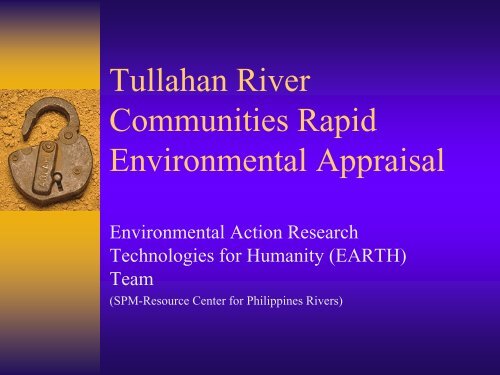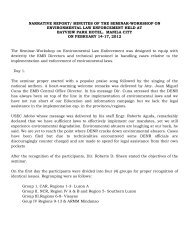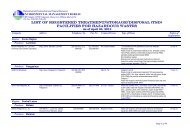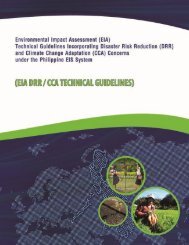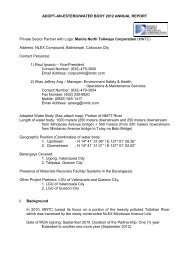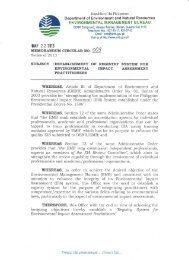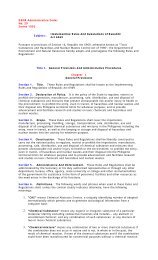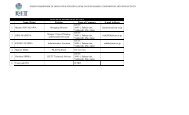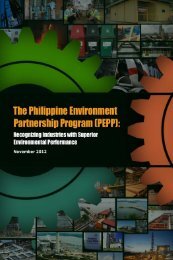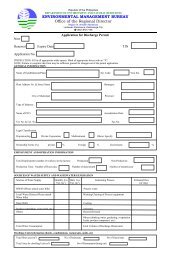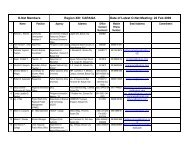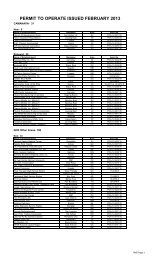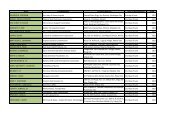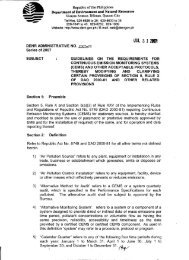Tullahan River Communities Rapid Environmental Appraisal
Tullahan River Communities Rapid Environmental Appraisal
Tullahan River Communities Rapid Environmental Appraisal
You also want an ePaper? Increase the reach of your titles
YUMPU automatically turns print PDFs into web optimized ePapers that Google loves.
<strong>Tullahan</strong> <strong>River</strong><br />
<strong>Communities</strong> <strong>Rapid</strong><br />
<strong>Environmental</strong> <strong>Appraisal</strong><br />
<strong>Environmental</strong> Action Research<br />
Technologies for Humanity (EARTH)<br />
Team<br />
(SPM-Resource Center for Philippines <strong>River</strong>s)
From EMB-NCR
RESEARCH OBJECTIVES
We went to the community to assess the general environmental<br />
condition, with emphasis on solid waste management situation, of<br />
the <strong>Tullahan</strong> river community/ies<br />
Specifically, we seek to<br />
Describe the psycho-social environment of the river community/ies and<br />
its implications to the rehabilitation and management/development of<br />
the river<br />
Look into the relationships and interactions between the physical and<br />
human, social factors operating within the surrounding environment of<br />
the river and its tributaries by looking at<br />
– The existing land use plan against the actual at the city and community level<br />
– The type of activities dominant in the community and the kind of waste<br />
generated in the area<br />
Examine the generation pattern and management of solid waste of<br />
Brgy Potrero, Malabon City
RESEARCH METHODOLOGY
Research Methods<br />
Case Study<br />
Survey<br />
Informal Interviews and Pagpapakwento<br />
Reconnaissance<br />
Photo Documentation<br />
Document Analysis
Target Barangays/<strong>Communities</strong><br />
# Malabon City Population # Valenzuela City Population<br />
1 Potrero 45,081 1 Marulas 54,753<br />
2 Tinajeros 18,387 2 Gen T. De Leon 95,536<br />
3 Ugong<br />
# Quezon City Population # Quezon City Population<br />
1 Bagbag 33,249 8 Commonwealth 172,834<br />
2 Talipapa 34,632 9 Sta Monica 44,186<br />
3 San Bartolome 44,631 10 Sta Lucia 24,050<br />
4 Gulod 56,620 11 Sauyo 67,587<br />
5 Nagkaisang Nayon 46,064 12 San Agustin 22,284<br />
6 Pasong Putik 28,848 13 Novaliches Proper 14,737<br />
7 Holy Spirit 106,038 14 Fairview 47, 464<br />
# Kalookan City Population # (downstream) Population<br />
1 160 --<br />
2 162<br />
3 163
RESEARCH FINDINGS
1. Psycho-Social Environment<br />
In this study “psycho-social environment”<br />
refers to<br />
– the thoughts, perceptions, and relationships of<br />
the people in the community regarding the<br />
<strong>Tullahan</strong> river and its condition, solid waste<br />
management, and other concerns relating to<br />
community life mentioned in this study.
Respondents: Gender<br />
Lalaki: 402<br />
Babae: 748<br />
Bilang ng mga Lalake at Babae<br />
Lalake<br />
35%<br />
Babae<br />
65%
Respondents: Civil Status<br />
Iba/Biyud<br />
o/Biyuda<br />
1%<br />
Binata<br />
15%<br />
Dalaga<br />
13%<br />
Mayasawa<br />
71%
Two Types of Residential Settler<br />
Settlers are of two types: the formal settlers<br />
(homeowners and industries) and a majority<br />
of informal settlers (estimated at about<br />
5,000 families along the river stretch) and
Healthy <strong>Communities</strong><br />
The people generally see themselves and<br />
their families as healthy. At the upstream,<br />
most of the respondents think their<br />
environment is just fine; at the midstream,<br />
many of the respondents think their<br />
environment is not fine. The majority think<br />
sanitation in their community is just fine.
Survey Question and Response<br />
48. Nabibigyan ba ng sapat na nutrisyon sa pagkain ang miyembro<br />
ng pamilya?<br />
80<br />
70<br />
60<br />
50<br />
40<br />
30<br />
20<br />
10<br />
0<br />
Oo Hindi Minsan Hindi tiyak
Rich and Poor Divide<br />
the river appears to be reflective of the rich<br />
and poor divide in our society with the poor<br />
seemingly being united with or associated<br />
with the river.
<strong>River</strong> bank Informal Settlers<br />
City<br />
IS<br />
Quezon City 1260<br />
Kaloocan 600<br />
Valenzuela 1072<br />
Malabon 2124<br />
Total 4956
Survey Question and Response<br />
1. Ang inyong lupa po ba ay<br />
pag mamay-ari?<br />
Hindi<br />
58%<br />
Oo<br />
42%<br />
60<br />
50<br />
40<br />
30<br />
20<br />
10<br />
0<br />
2. Ang inyong bahay po ba ay?<br />
56.61<br />
27.48<br />
15.91<br />
Pag-aari Nakikitira Inuupahan
The <strong>River</strong> is for the Poor<br />
The river is for the poor. “Only the poor<br />
goes to the river,” says one of the affluent<br />
interviewee, a riverbank resident. The river<br />
is dirty, unpleasant and neglected; it looks<br />
like one of the margins in our society.
Brgy Potrero: Settlers at the<br />
stretch of the river bank
Brgy Marulas: A Colony of Informal<br />
Settlers too…
Brgy Ugong: A colony of informal<br />
settlers
QC: A colony of informal settlers not only<br />
in the riverbanks but on the riverbed as<br />
well…
Informal Settlers<br />
“Informal settlers occupy not only vast<br />
tracts of public and private lands but also<br />
riverbanks, creeksides, aqueducts and<br />
transmission lines.” (Emphasis mine, QC<br />
CLUP, p. 17)
There is SWM Problem in the<br />
community<br />
Most of the respondents think their community<br />
has problems with solid waste management but<br />
most of them are also contented with the waste<br />
management in their community though.<br />
Many of them also think there is a problem in the<br />
quality of the air they breathe. Most of the<br />
respondents agree that something has to be done in<br />
resolving the problem on solid waste management<br />
and that the burden is both on the government and<br />
the people.
Survey Question and Response<br />
16. May mga suliranin po ba kayo sa<br />
inyong kapaligiran Sa pamamahala sa<br />
basura<br />
Wala<br />
44%<br />
Meron<br />
56%
Who throws garbage into the<br />
river?<br />
Hard evidences of which communities throw<br />
waste straight into the river, or through<br />
waterways<br />
– Residents of Elysian Subdivision near F Bautista<br />
Street, Marulas, Valenzuela City<br />
– Residents of Brgy Potrero around Dona Juana<br />
Street, Malabon, City
Settlers on both sides of the river<br />
dump garbage into the river
Gen T. De Leon, VC - Libis, KC
The woman getting inside their shack just<br />
threw two bags of garbage into the river:<br />
the green and white bags floating…
Brgy Ugong, VC – Sta Quiteria,<br />
KC
<strong>Tullahan</strong> <strong>River</strong><br />
Sta Monica, QC, 2009<br />
<strong>Tullahan</strong> <strong>River</strong><br />
Talipapa – San Bartolome, QC, 2009<br />
<strong>Tullahan</strong> <strong>River</strong><br />
Odelco Subdivision, San Bartolome, QC, 2009<br />
<strong>Tullahan</strong> <strong>River</strong><br />
Odelco Subdivision, San Bartolome, QC, 2009
38. Ano po ang pumapasok sa isipan ninyo<br />
kapag nababanggit ang ilog o batis sa inyong<br />
lugar?<br />
68.26<br />
37.57<br />
17.48 15.3<br />
6.174<br />
Marumi Basura Mga squatters Patay na hayop Iba pa
Is the entire river loaded with<br />
garbage?
Except for some floating debris,<br />
the waters here are clearer…
QC Upstream: At last! We still have<br />
clear waters in the river…
2. Relationships and Interactions<br />
between the Physical and Human,<br />
Social Factors in the Community
The relationships and interactions between the physical and human, social<br />
factors operating within the surrounding environment of the river and its<br />
tributaries: Land Use<br />
Potrero <strong>River</strong> Community<br />
– Mainly Industrial and Commercial<br />
– Partly Residential<br />
– Some Vacant Lots<br />
– Waterways invaded by settlers<br />
Marulas <strong>River</strong> Community<br />
– Partly Industrial<br />
– Partly Residential<br />
– Some Vacant Lots<br />
– Waterways
The relationships and interactions between the physical and human, social<br />
factors operating within the surrounding environment of the river and its<br />
tributaries: Land Use<br />
QC <strong>Communities</strong> Mid Stream<br />
– Mainly Industrial<br />
– Partly Residential<br />
– Waterways invaded by settlers<br />
QC <strong>Communities</strong> Upstream<br />
– Mainly Residential<br />
– Partly Commercial and Institutional, e.g., schools<br />
– Waterways invaded by settlers
A ghastly river…
Bubbling and reddish water,<br />
pinkish rocks
Reconnaissance Data<br />
January – February 2009<br />
LIFE IN THE RIVER BANKS
Fishing?
Fishing in <strong>Tullahan</strong> <strong>River</strong><br />
We met a senior citizen in a middle class<br />
subdivision in Brgy Fairview and asked him<br />
what they do in the river when its waters<br />
were still clean, he said:<br />
– “May mga mangingisda d’yan noon.<br />
Nanghuhuli sila ng isda…”
Fishing Activities in the <strong>River</strong><br />
Quezon City (January 2009) Valenzuela City (February 2009)<br />
Brgy Marulas<br />
Photos by Chot, „09<br />
Brgy Fairview<br />
Photos by Chot, „09
Fish in <strong>Tullahan</strong> <strong>River</strong><br />
Fish found in the “Tulyahan” <strong>River</strong> in the<br />
past<br />
– Dalag<br />
– Hito<br />
– Martinico<br />
– Palos<br />
– Pawikan (soft shelled)
“Walang Kusina o<br />
Kubeta”<br />
These two women seem to<br />
have adapted well to their<br />
situation. In the absence of<br />
space for bathroom and<br />
kitchen, they are still able<br />
to do their personal and<br />
family concerns.<br />
The woman on the lower<br />
right is taking a bath in full<br />
view of those at the other<br />
side of the river; the<br />
woman on the left is<br />
fetching water from a hose<br />
connected to a water<br />
supply pipe somewhere.<br />
“Buhay sa Tabing Ilog”<br />
Brgy Potrero, Malabon City<br />
Photo by Chot, February „09
Watercrafts<br />
“Balsa” is a native water<br />
vessel made out of<br />
bamboos; it is commonly<br />
used in rivers and other<br />
small water bodies for<br />
carrying people and some<br />
goods on short distance<br />
travels like crossing the<br />
river. Apparently, there<br />
are other improvised<br />
watercrafts resembling a<br />
“balsa” just like the blue<br />
floater of the child shown<br />
in this photo (inset at the<br />
top right).<br />
Sta Quiteria, Kal City<br />
Feb, „09<br />
Watercraft<br />
Brgy Ugong, Val City<br />
“Balsa”<br />
Brgy Potrero, Malabon City<br />
Photo by Chot, Feb „09<br />
Photo by Chot, Jan „09
“Pangangalakal”<br />
This man collects<br />
recyclable waste from<br />
floating debris in the river.<br />
Children also do the same<br />
thing in other parts of the<br />
river.<br />
“making a living out of a dying river”<br />
Brgy Marulas, Valenzuela City<br />
Photo by Chot, February 2009<br />
“nangangalakal”<br />
Brgy Ugong, Valenzuela City<br />
Photo by Chot, January 2009
Livestock: Hog raising<br />
Small scale hog raising was<br />
observed in Brgy Marulas,<br />
Valenzuela City and in Libis,<br />
Kalookan City. The cages<br />
were erected at the river<br />
bank; presumably the manure<br />
of these pigs go directly to the<br />
river.
Drainage System…<br />
If our communities were designed that our waste water<br />
ends up in the river, should we be surprised that our solid<br />
waste also ends up in the river?
3. Pattern of Solid Waste<br />
Generation and Management of<br />
Brgy Potrero
<strong>River</strong> Community of Brgy<br />
Potrero, Malabon City<br />
“Potrero” – Spanish, pasture or grazing<br />
land for animals*<br />
A sanctuary of the Katipuneros because of<br />
its proximity to Balintawak<br />
“Batteryas” was constructed within the<br />
barrio to defend themselves (Katipuneros)<br />
Farming and fishing were the means of<br />
livelihood, including wood gathering for<br />
fuel<br />
Population of 45,081 (as of 2007)<br />
[*Barangay Profile, (Data retrieved 08 January 2009) History of Barangay Potrero, Unpublished Paper]
Sources of Solid Waste<br />
Individuals<br />
Households/Residences<br />
Industries, Factories and Commercial<br />
Establishments (waste is self managed,<br />
except for some)
Patterns of Solid Waste Generation and<br />
Management of Potrero <strong>River</strong> Community,<br />
Malabon City<br />
Solid Waste Handling (SWH) Patterns*<br />
Pattern 1: Litters/Discards and Mixed Waste<br />
Dumped Within the Community<br />
Pattern 2: Mixed Waste Dumped Outside the<br />
Community<br />
Pattern 3: Segregated Wastes/Discards<br />
Managed Inside/Outside the Community<br />
Pattern 4: Reduced Waste Handled at<br />
Disposal Site/s<br />
*[Chot Velasquez, (2008), Solid Waste Handling Patterns in Metro Manila,<br />
Unpublished Article]
Solid Waste Handling Pattern/s<br />
of Potrero <strong>River</strong> Community<br />
Potrero <strong>River</strong> Community observes SWM<br />
Patterns 1 and 2
The Waste/Discards Situation<br />
Where would this waste<br />
end up?
Waterways Disposal Site…<br />
Here?
Guarded Community Waste Drop<br />
Off Point: Macopa Street, Potrero<br />
Or Here?<br />
22 December 2008<br />
29 December 2008
Solid Waste Handling Pattern 1<br />
Litters/Discards and Mixed Waste<br />
Dumped Within the Community<br />
Individuals, households and establishments<br />
generate waste, and in the absence of<br />
efficient and systematic ecological solid<br />
waste management program, these refuse<br />
end up everywhere
Solid Waste Handling Pattern 2<br />
Mixed Waste Dumped Outside the<br />
Community<br />
Unguarded Drop Off Point<br />
Waste Barge, Pier 18,<br />
Manila<br />
Waste Collectors:<br />
Freelance to Org<br />
commissioned individuals,<br />
including children<br />
Guarded Drop Off Point<br />
Unguarded <strong>River</strong> and<br />
Waterways<br />
Dump truck collects<br />
waste at Drop Off<br />
Points, except<br />
those at the<br />
waterways and the<br />
river, and take it to<br />
Pier 18 or to<br />
Catmon Dumpsite
Solid Waste Management Issue/s<br />
What about the materials recovery and<br />
community clean up drive/activities in the<br />
community, e.g., IBBNA‟s initiative, and<br />
that of others? Are they not evidences of<br />
Pattern 3 of Solid Waste Handling/<br />
Management in the community?<br />
IBNNA in Action:<br />
Community Clean Up<br />
Photo courtesy of IBBNA, Inc.
No evidence of SWH Pattern 3<br />
Materials recovery as described in RA 9003 is<br />
expected to start at the household (source) level<br />
and community-wide. IBBNA’s initiative and that<br />
of others are not segregation at source and covers<br />
only a very small area in the community. More<br />
so, the initiators are not aware of RA 9003, which<br />
make it very unlikely as compliance to the law or<br />
directly in relation to it. At best, they could be<br />
considered environmentally related and income<br />
generating activities, which are common across<br />
the country and ever since. Thus, it could hardly<br />
be considered that the community has Pattern 3 of<br />
solid waste management.
Community Organizations<br />
There are numerous organizations in Brgy Potrero;<br />
some could be tapped for environmental projects as<br />
they expressed openness/willingness to participate,<br />
e.g., Industrial, Bignay, and Baggao Neighborhood<br />
Association (IBBNA)
RA 9003 Implementation<br />
RA 9003 is very poorly implemented, if not<br />
totally neglected, in the communities of<br />
Malabon and Valenzuela cities<br />
– Mixed Waste<br />
– Unsanitary Drop Off Points in Brgy Potrero<br />
– IEC is very little to nothing<br />
– Many are not aware of the idea of segregation
Waste Management Efforts<br />
There are efforts towards environment<br />
conservation<br />
RA 9003 implementation in Quezon City<br />
Community clean up and materials<br />
recovery in Brgy Potrero<br />
Some residents and organizations in the<br />
communities express interest in implementing<br />
waste management programs
Observations<br />
There were no indicative signs of any felt<br />
urgent need to reduce generation of waste<br />
Waste management in the community<br />
perceived as the duty of the LGU<br />
“Not in my backyard” or outside the<br />
“sakop” might be worth exploring further
Assessment of <strong>Environmental</strong> Condition<br />
of the <strong>Tullahan</strong> <strong>River</strong> <strong>Communities</strong><br />
<strong>Environmental</strong> condition, particularly the<br />
ecological solid waste management, of the<br />
<strong>Tullahan</strong> river communities remains very poor<br />
– Waste reduction very unlikely<br />
– Waste are mixed, litters everywhere, refuse in<br />
waterways and the river<br />
– Waste diversion appears minimal<br />
– Materials Recovery Facility (MRF), if any, not visible<br />
to constituents<br />
– LGU efforts on SWM perceived very low<br />
– RA 9003 enforcement/implementation is very weak
Observation<br />
A systematic solid waste mismanagement<br />
is in practice in the river communities of<br />
Brgy Potrero and Brgy Marulas
“Show me a dirty place<br />
and I will show you a dirty<br />
leader…”<br />
(Quoted by Chairman Rolly Datiles, Brgy Bagumbuhay, Proj 4, Q.C.)


